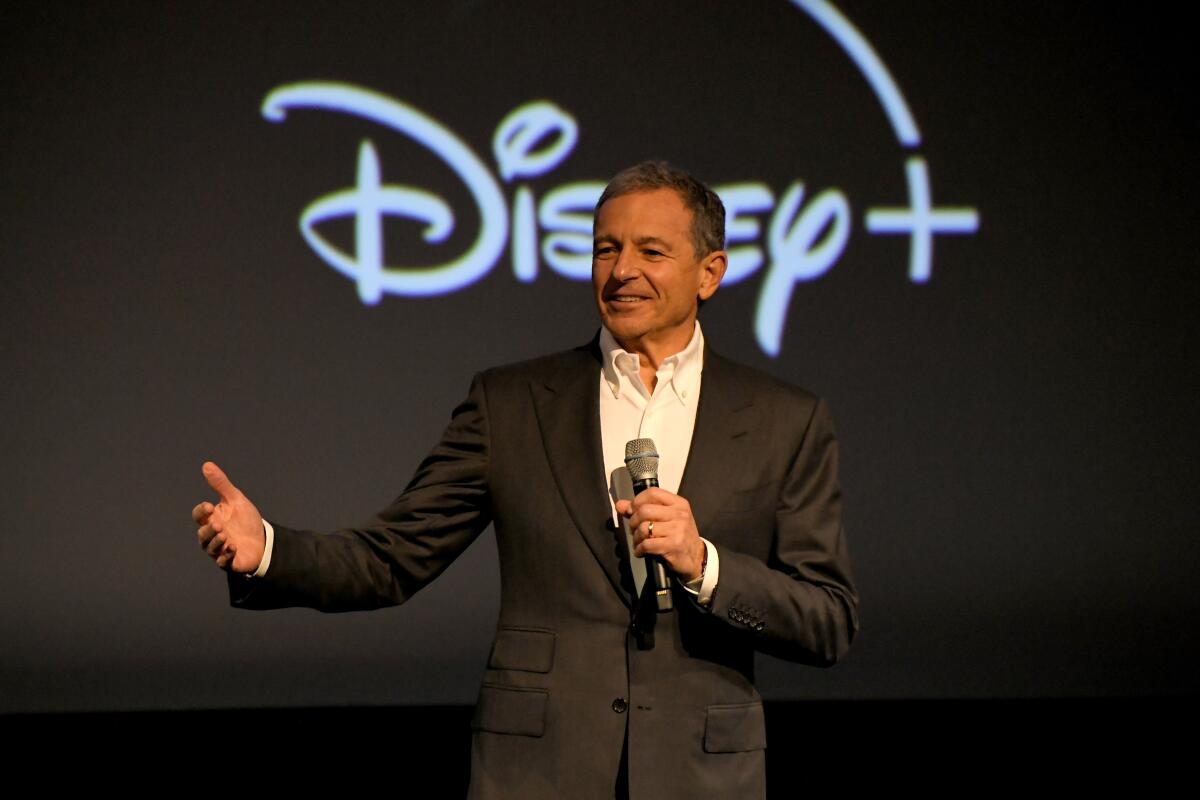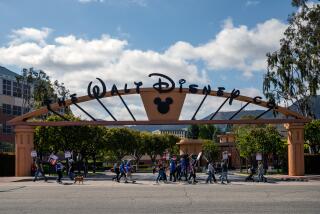Disney to hike Disney+ prices again in a quest for streaming profits

- Share via
Walt Disney Co.’s latest quarterly earnings report, released Wednesday, illustrates the catch-22 facing big media companies: old-school TV still turns a profit but is on the decline, while streaming is growing but remains a money-loser.
It’s a transitional moment for the entertainment industry that — on top of a Hollywood strike wave that has ground production schedules to a halt — leaves the House of Mouse navigating economic pressures and tough strategic decisions.
Inside the business of entertainment
The Wide Shot brings you news, analysis and insights on everything from streaming wars to production — and what it all means for the future.
You may occasionally receive promotional content from the Los Angeles Times.
Central to the company’s economic trajectory is whether its direct-to-consumer offerings — Disney+, ESPN+ and Hulu — can take the place of declining linear businesses such as ABC and ESPN.
Disney reported operating income of about $1.9 billion for its linear networks for its fiscal third quarter, which marked a 23% decline from the same metric this time last year. Meanwhile, its streaming ventures lost $512 million, though that was half the $1.1 billion in negative operating income it posted a year earlier.
Disney attributed linear TV’s shrinking profitability to a variety of factors including lower viewership and advertising revenue at ABC; higher costs for sports programming on cable, especially for motor sports and the NBA; and a downturn in its international channel income, where operating results plummeted from $166 million to a loss of $87 million.
Disney Chief Executive Bob Iger has said the company is considering options for strategic partners for ESPN to help the sports cable behemoth’s transition to a direct-to-consumer model. Iger has also indicated a willingness to weigh options for its TV networks business, including a spinoff of ABC.
The improvement in streaming was thanks to shrinking losses by Disney+, the conglomerate’s flagship platform, which enjoyed higher subscription revenue and lower marketing costs, as well as lower losses at ESPN+ and higher operating income at Hulu. Disney reported that its direct-to-consumer revenue for the third quarter grew 9% to $5.5 billion.
The firm previously promised investors that it would turn its streaming businesses profitable by the end of fiscal 2024.
To that end, Disney is raising the price of its ad-free version of Disney+ from $10.99 a month to $13.99 a month later this year, the company said Wednesday. Its ad-supported tier will remain $7.99 a month. Disney also announced that it will launch an ad-supported Disney+ option in Canada and in some European countries this November, plus an ad-free Disney+ and Hulu bundle domestically in September that costs $19.99 a month.
Subscription is the name of the game when it comes to streamers, and for Disney, that story is mixed. Since last quarter, the company saw slight losses in the number of paying Disney+ subscribers domestically, but slight gains internationally (excluding its struggling Indian platform Hotstar).
“Core” Disney+ subscriptions (which do not include the Indian service) increased 800,000 to reach 105.7 million during the quarter.
Disney+ saw growth in its average monthly revenue per paying subscriber both domestically and internationally. That is to say: even as the platform lost American users, it tended to make more off those it retained, thanks to an increase from advertising revenue.
In a bid to compete with Netflix and its ilk, Disney charged headlong into the streaming wars, funneling money into original content. But keeping the streaming growth going isn’t easy. Disney+ lost 4 million subscribers last quarter and 2.4 million the quarter before that.
Subscriber losses from India accelerated in the third quarter, thanks to Disney no longer having the rights to stream Indian Premier League cricket matches. Disney+ Hostar subscribers fell by 12.5 million during the quarter, hitting 40.4 million.
Overall, Disney reported mixed third-quarter results. The company saw adjusted earnings per share, excluding certain items, fall to $1.03 in its fiscal third quarter, down 6% from the same quarter last year. Revenue, however, increased 4% to $22.3 billion.
Disney’s profit beat estimates by Wall Street analysts, who on average projected earnings of 96 cents a share, according to FactSet. Revenue missed analyst estimates of $22.5 billion.
“Our results this quarter are reflective of what we’ve accomplished through the unprecedented transformation we’re undertaking at Disney to restructure the company, improve efficiencies, and restore creativity to the center of our business,” said Iger, who last fall returned to the Burbank-based entertainment giant after having left less than a year prior.
Iger, who restructured the company and dramatically cut costs after returning, added that the company now expects to exceed the $5.5 billion in savings it had previously promised Wall Street. The firm went through several rounds of layoffs, cutting about 7,000 positions.
Disney’s parks, experiences and products segment, which includes Disneyland, saw its operating income increase 11% to $2.4 billion.
That was thanks in large part to post-pandemic changes at the company’s international parks, especially ones in Shanghai and Hong Kong.
Domestic park results were lower, which Disney attributed in part to a decrease at Walt Disney World Resort due to higher costs — including ones related to the planned closure of “Star Wars: Galactic Starcruiser” — and lower attendance.
The company also noted a $90-million gain on its investment in the sports betting company DraftKings, which Disney says was sold during the current quarter. ESPN is now moving into the sports betting business as well, through a deal with gambling company Penn Entertainment.
This earnings report comes during the fraught Hollywood strike.
SAG-AFTRA, the labor union for actors, and the Writers Guild of America are both currently on strike. Both unions were motivated by frustration with how residuals in the streaming industry are structured, as well as concerns about the rising role of artificial intelligence in Hollywood.
“Nothing is more important to this company than its relationships with the creative community,” Iger said during a call with analysts to discuss earnings. “I have deep respect and appreciation for all those who are vital to the extraordinary creative engine that drives this company and our industry,” he said.
Iger’s comments were more conciliatory than his past remarks on the strikes. Iger had previously called the unions’ demands “not realistic” and ill-timed, given the media sector’s ongoing struggles to deal with a shaky post-COVID economy and the transformative rise of streaming.
“You also have to be realistic about the business environment and what this business can deliver,” Iger said at the time in an interview with CNBC.
More to Read
Inside the business of entertainment
The Wide Shot brings you news, analysis and insights on everything from streaming wars to production — and what it all means for the future.
You may occasionally receive promotional content from the Los Angeles Times.











